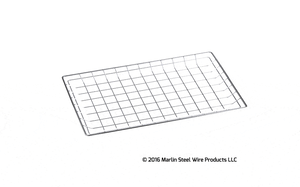 For each and every custom basket or tray design Marlin Steel makes, there’s a set process from start to finish to help ensure consistency, quality, and rapid deployment. This is true of every order, small or large, simple or complex.
For each and every custom basket or tray design Marlin Steel makes, there’s a set process from start to finish to help ensure consistency, quality, and rapid deployment. This is true of every order, small or large, simple or complex.
Recently, Marlin was approached by a mechanical engineer from an equipment development firm to design new stainless steel wire trays with dividers for a set of sub-zero freezers.
Each tray would have to support a max load of 250 lbs. while maintaining the lightest possible weight for the tray itself.
The reason for the lightweight obsession for a heavy-duty freezer basket? The mechanical engineer at the equipment development company wants to minimize the thermal mass of each tray. This way, the thermal load put on the freezers to cool a “warm” tray is kept to a minimum, reducing power draw and stress on the equipment.
Choosing the Right Material for the Job
In this instance, the engineer from the equipment development company had two primary kinds of stainless steel in mind for the freezer application:
- Grade 304 Stainless Steel. A common multi-application stainless steel alloy with good corrosion resistance and tensile strength.
- Grade 316L Stainless Steel. A less-common variant of 316 stainless that has a lower carbon content. Has an even higher corrosion resistance than 304 SS, particularly to chlorides.
Both of these alloys can be hardened by cold working—meaning that the act of bending the wires for the basket can contribute to increased surface hardness & tensile strength.
The engineer’s application did not call for extreme corrosion resistance, as the trays would primarily be kept in the freezers at temperatures as low as -86°C (-122.8°F) with very infrequent washing to keep the trays clean—occasional condensation would be the biggest chemical resistance concern.
What was most important was picking a material that could take sub-freezing temperatures without becoming brittle under a 250 lb. load. This is something that both materials could do. In the end, the choice came down to which material had the lowest thermal mass per cubic inch—which was the grade 316L alloy.
Eliminating Sharps
While the engineer’s process did call for a robotic assembly to load and unload the fully-loaded trays, burrs and sharps in the surface of the metal remained an enormous concern. The engineer’s company didn’t want to risk anyone getting hurt by a sharp bit of metal. After all, human workers would still frequently interact with the trays while loading or unloading them.
To cut down on the kinds of flaws that could cause harm to a person, Marlin Steel has several tools at its disposal, from grinding and wet belt sanding machines that can strip burrs from trays to electropolishing processes that leave microscopically-smooth surfaces.
Either of these two processes would work for removing burrs/sharps from the surface of any wire tray. Electropolishing has the added benefit of improving stainless steel’s oxidation resistance, while wet-belt sanding and grinding is better at removing particularly large flaws.
Making Sure the Trays Fit the Freezer
The freezers used in this applications would be small compared to the walk-ins employed by the food industry. These super-freezers would keep their contents at temperatures well below the minimum temperatures used in the food industry, so larger units would be cost-prohibitive to maintain.
Two different sizes of trays were needed for different sub-freezer compartments. Most of the shelf spaces were 34” by 27”, but some of the others were 30” by 24” instead. Marlin confirmed these dimensions for the freezer shelves by using a combination of specific questions in the questionnaire and by reviewing design documents from the engineer featuring their freezers.
On top of this, the engineer’s design needs called for the trays to be loaded and unloaded by robotic lift platforms equipped with rollers. To bridge the gap between the frame of the basket and the rollers, the basket needed to have a set of plastic skids attached to the sides—but the design of the lift platform hadn’t been finalized, so the exact distance between the basket frame and the rollers was unknown.
For most projects, this would put everything on hold. However, there was a solution to this problem: rather than waiting for the dimensions of the lift platform to be finalized, Marlin’s degreed engineers would design into the basket a mounting that a plastic skid could be attached to later. This would allow either Marlin or the client to create the plastic skids once the platform design was finalized.
An additional design consideration was that the engineer needed adjustable dividers that could go along both the X and Y axes of the tray—largely to keep different containers easily sorted and separated. Since the size of each container would vary, it was necessary to ensure that the dividers could be mounted in different positions on the tray to prevent products from shifting on the tray.
Checking the Design Against Sub-Freezing Temperatures
After finalizing the design concept for the basket, Marlin rand a series of virtual physics tests using Autodesk simulation software. By using a virtual test, Marlin’s degreed engineers could check how months or years of use at sub-freezing temperatures would affect the integrity of a fully-loaded tray.
Any failures that were noted during the tests had detailed reports generated that listed the causes/contributing factors to the failure. This, in turn, allowed Marlin’s degreed engineers to specifically rework the design to prevent such failures, all without committing any material to a physical prototype.
This virtual physics simulation is just another part of how Marlin Steel delivers Quality, Engineered Quick® to other manufacturers the world over—driving production efficiencies through superior quality and tight delivery timetables.



.gif)


